In today's workforce, small and medium-sized businesses (SMBs) often employ individuals from multiple generations. Bridging the generation gap and effectively managing performance is crucial for fostering a cohesive and productive work environment.
Let's explore the challenges and opportunities that arise in managing a multigenerational team.
Understanding the Generational Differences
Each generation brings unique characteristics, values, and communication preferences to the workplace.
For example, Baby Boomers, who grew up during a time of economic growth, tend to value job stability and loyalty. On the other hand, Millennials and Generation Z employees, who are more digitally native, prioritize work-life balance and opportunities for growth and development.
Recognizing and understanding these differences is key to successful performance management and fostering collaboration.
Fostering Collaboration and Communication
To promote collaboration among different generations, SMBs should create an inclusive and open work environment.
For instance, facilitating cross-generational team projects and encouraging knowledge-sharing sessions can help employees learn from one another's perspectives and experiences.
This kind of collaboration fosters a sense of unity and breaks down barriers between generations.
Leveraging Strengths and Skills
Every generation has valuable strengths and skills to offer.
- Baby Boomers bring decades of experience, leadership qualities, and a strong work ethic.
- Generation X employees, known for their adaptability, independence, and multitasking skills, can contribute to problem-solving and innovation.
- Millennials, with their tech-savviness and creativity, can bring fresh perspectives to projects.
- Generation Z employees, being digitally native and entrepreneurial, can offer insights into emerging trends and technologies.
By leveraging these diverse strengths, SMBs can build high-performing teams that benefit from a range of skills and expertise.
Bridging the Gap: Managing Performance
To effectively manage performance in a multigenerational workforce, SMBs should set clear expectations and provide regular feedback.
Implementing a structured performance review process that includes ongoing check-ins and feedback sessions helps to align expectations and provides opportunities for growth.
Tailored development opportunities that consider the individual needs and aspirations of employees from different generations, such as mentorship programs or training workshops, can further enhance performance and engagement.
Building a Positive Work Culture
Creating a positive work culture is essential for bridging the generation gap.
SMB leaders should set the tone by promoting a culture of respect, inclusivity, and collaboration.
Organizing team-building activities that involve intergenerational interactions and celebrating diverse perspectives can foster a sense of belonging and shared purpose. Encouraging cross-generational mentorship programs where employees can learn from one another's experiences and insights also contributes to a positive work culture.
For more on this, check out our post, Building a Company Culture from Scratch
Overcoming Challenges
By bridging the generation gap, SMBs can unlock the full potential of their multigenerational workforce. Embracing diversity, leveraging strengths, and nurturing a positive work culture are essential steps toward empowering performance and driving success.
When leaders actively manage and bridge the generation gap, employees from all generations can thrive, contribute their best work, and achieve collective goals.





